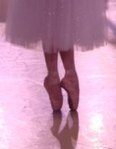
En pointe
Last Saturday night, I watched my granddaughter dance in a performance of Beauty and the Beast. She is an exceptional dancer—she really is, and not just because she’s mine—and she’s really quite beautiful. At twelve, she is incredibly strong, precise, and graceful en pointe. And she’s an actress, too; she understands the necessity of portraying emotion through movement and expression. She is the dancer I wanted to be as a child but never could have been, not just because the nearest dance classes were twenty miles away. I was not exactly a graceful child.
But I dreamed about it. When I was little, I wanted to be a ballerina. My inspiration was a coloring book, of all things. I don’t remember where the coloring book came from; maybe the local dime store that Mr. Vester Page owned. I went there often. Usually, it was Daddy who would take me to buy a treat, some trinket: balloons, I loved balloons, or jacks, or crayons or watercolors. I loved that store, and the mynah bird he kept in the back that whistled and squawked, “Pretty bird!” “Pretty girl!” So this particular time, the summer before I turned six, there must have been that coloring book. I can still see the simple, stark line drawings of dancers in what I now know are “positions,” ballerinas in tutus with flowers or tiaras in their hair, male dancers who looked like princes out of a fairy tale. But they were motionless, frozen on the pages. What I don’t remember is how I learned that these frozen images represented so much more. But somehow, I knew that those poses needed to be translated into movement. And so I hatched a plan.
I recruited a few neighborhood kids to participate in my ballet. We studied the pictures in the book and practiced the poses. There was no continuity of movement, just those static positions. We would stage one, stop, then another, stop. Rearrange ourselves and start again. And because there was probably no boy in the neighborhood big enough or strong enough (or gullible enough) to be coerced into doing it, I recruited my daddy to play the prince: to lift me up in that final, dramatic pose that signaled the happy, triumphant ending.
The performance was to be on a Saturday evening, after supper but before sundown, in our front yard. It was steamy hot, late summer. I remember wearing a yellow halter sundress that was as close as I could come to a tutu. I was nervous, excited. And then, just before suppertime, my mother declared that I had to wash my hair. Before the “ballet,” not after. The next day was Sunday, after all, and she wanted my hair dry before bedtime. This was back in the days of the attic fan, which my mother was convinced caused me to catch cold if I slept in its draft at night, and going to bed with wet hair would court disaster. Usually, I could wear her down, but not this time. She would not give. She washed my hair and put it up in pin curls.
So at “showtime,” I appeared in my pretty yellow dress with my hair in pin curls and, most likely, with my eyes red from crying. I was mortified, but stubborn. I would have my ballet, no matter what. And I did. It must have lasted all of ten minutes—we awkward little kids using the coloring book as the guide for our “dance,” and Daddy lifting me high in the air at the end. No music. A little clapping.
That was the beginning and end of my dancing. Within a year, we would have a piano in the house, and that would turn out to be the right artistic expression for me; it would become my graceful movement. I wanted this grandchild to take piano, to excel at it. And she did, but it just isn’t her thing. She’s a born dancer. And when I look at her in a certain light, although she looks so much like her beautiful mother, I can see a little of me in her. And maybe the spirit and the love of the dance I see in her was born in me, a long, long time ago.